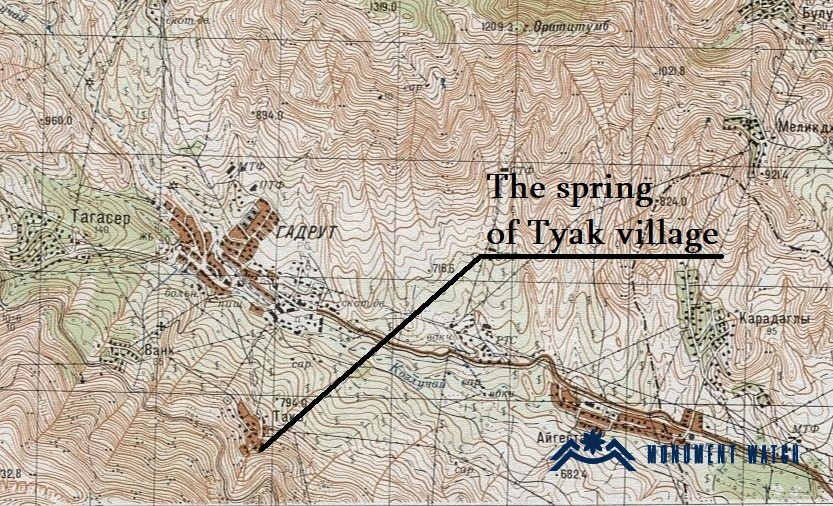The spring of Tyak village
Location
The Tyak village, located in the Hadrut region of occupied Artsakh, was designated as a reserve in 2017. The village is considered a prime example of the traditional folk architecture of 18th-19th century Artsakh. Its development serves as a unique representation of the period, characterizing the entire area as a significant monument.
The spring is situated in the southeastern part of Tyak village, serving as a unique focal point towards which all the narrow streets converge. It was constructed along the axis of the street that formed part of the road from Hadrut to Tsor (Sargsyan 1997, 11-12).
The spring and its surrounding area played a central role in the public life of Tyak village, serving as a gathering place for the villagers (Fig. 1). The site, particularly the adjacent grove of plane trees, also held a special sacred significance for the residents (Sargsyan 1997, 12).
Historical overview
There is no precise information regarding the spring's original construction. According to researcher M. Sargsyan, it was built in the 19th century and received its final form at the beginning of the 20th century, when a sloping tile roof was added to cover the spring (Sargsyan 1986, 63).
Architectural-compositional examination
The spring of Tyak village, along with its surrounding complex, is one of the most extensive and architecturally refined springs in Artsakh. The spring complex includes a reservoir that seamlessly integrates with the natural terrain, bordered by three large plane trees. Beneath one of these trees, a section is enclosed by a low stone wall, creating a communal gathering place for the villagers (Fig. 2). The spring structure is adjacent to the mountain slope.
The spring is constructed using local small and medium-sized limestone with lime mortar (Fig. 3). The roof is tiled. The main part of the structure is a vaulted hall with a niche in the left wall (Fig. 4). Due to the significant slope of the hall's nave, the right buttress of vault was widened and given a masonry appearance. Water was stored in a narrow underground vaulted garner, from which it flowed out through several taps, filling stone naves located under the arch (Sargsyan, 1986, pp. 63-64; Karapetyan, 2023, pp. 64-65).
The condition before and after the war
The spring remained undamaged during the Artsakh wars.
Bibliography
- Karapetyan 2023 - Karapetyan S., Armenian Springs, Yerevan.
- Sargsyan 1986 - Sargsyan M., Dizak's springs and the architecture of their structures, Journal of Social Sciences, No. 11, pp. 59-64.
- Sargsyan 1997 - M. Sargsyan, The historical development of Tyak village, an experience of a complex study of the transformation of the Armenian national settlement of Artsakh, Yerevan.
The spring of Tyak village
Artsakh




